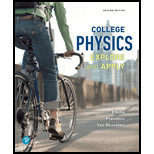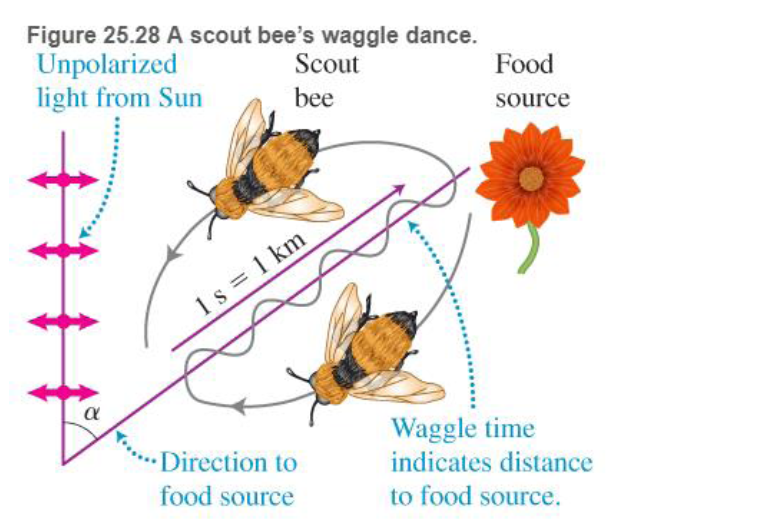
Concept explainers
BIO Amazing honeybees The survival of a bee colony depends on the ability of bee scouts to locate food and to convey that information to the hive. After finding a promising food source, a honeybee scout returns to the hive and uses a waggle dance to tell its worker sisters the direction and distance to the food.
Recall that light coming directly from the Sun is unpolarized. Bees use the direction of the Sun as a reference for their travel In the hive, the scout bee's waggle dance is in the shape of a flat figure eight (Figure 25.28). The upward direction in the vertical hive represents the direction toward the Sun. The middle line of the scout’s figure eight points in the direction of the food relative to the direction of the Sun. I hus a

Polar molecules are caused to vibrate in all directions perpendicular to the direction of travel of sunlight. When the Sun is rising in the east and you look at the molecules directly overhead, the light from these molecules is
a. unpolarized.
b. linearly polarized along an axis between you and the molecules overhead.
c. linearly polarized parallel to a plane with you, the Sun, and the molecules.
d. linearly polarized perpendicular to a plane with you, the Sun, and the molecules.
e. All of these are correct.
Want to see the full answer?
Check out a sample textbook solution
Chapter 25 Solutions
EBK COLLEGE PHYSICS
Additional Science Textbook Solutions
Chemistry: The Central Science (14th Edition)
Anatomy & Physiology (6th Edition)
Campbell Biology (11th Edition)
College Physics: A Strategic Approach (3rd Edition)
Microbiology with Diseases by Body System (5th Edition)
Applications and Investigations in Earth Science (9th Edition)
- 6. A car drives at steady speed around a perfectly circular track. (a) The car's acceleration is zero. (b) The net force on the car is zero. (c) Both the acceleration and net force on the car point outward. (d) Both the acceleration and net force on the car point inward. (e) If there is no friction, the acceleration is outward.arrow_forward9. A spring has a force constant of 100 N/m and an unstretched length of 0.07 m. One end is attached to a post that is free to rotate in the center of a smooth. table, as shown in the top view in the figure below. The other end is attached to a 1kg disc moving in uniform circular motion on the table, which stretches the spring by 0.03 m. Friction is negligible. What is the centripetal force on the disc? Top View (a) 0.3 N (b) 3.0 N (c) 10 N (d) 300 N (e) 1000 Narrow_forward4. A child has a ball on the end of a cord, and whirls the ball in a vertical circle. Assuming the speed of the ball is constant (an approximation), when would the tension in the cord be greatest? (a) At the top of the circle. (b) At the bottom of the circle. (c) A little after the bottom of the circle when the ball is climbing. (d) A little before the bottom of the circle when the ball is descending quickly. (e) Nowhere; the cord is pulled the same amount at all points.arrow_forward
- 3. In a rotating vertical cylinder (Rotor-ride) a rider finds herself pressed with her back to the rotating wall. Which is the correct free-body diagram for her? (a) (b) (c) (d) (e)arrow_forward8. A roller coaster rounds the bottom of a circular loop at a nearly constant speed. At this point the net force on the coaster cart is (a) zero. (b) directed upward. (c) directed downward. (d) Cannot tell without knowing the exact speed.arrow_forward5. While driving fast around a sharp right turn, you find yourself pressing against the left car door. What is happening? (a) Centrifugal force is pushing you into the door. (b) The door is exerting a rightward force on you. (c) Both of the above. (d) Neither of the above.arrow_forward
- 7. You are flung sideways when your car travels around a sharp curve because (a) you tend to continue moving in a straight line. (b) there is a centrifugal force acting on you. (c) the car exerts an outward force on you. (d) of gravity.arrow_forward1. A 50-N crate sits on a horizontal floor where the coefficient of static friction between the crate and the floor is 0.50. A 20-N force is applied to the crate acting to the right. What is the resulting static friction force acting on the crate? (a) 20 N to the right. (b) 20 N to the left. (c) 25 N to the right. (d) 25 N to the left. (e) None of the above; the crate starts to move.arrow_forward3. The problem that shall not be named. m A (a) A block of mass m = 1 kg, sits on an incline that has an angle 0. Find the coefficient of static friction by analyzing the system at imminent motion. (hint: static friction will equal the maximum value) (b) A block of mass m = 1kg made of a different material, slides down an incline that has an angle 0 = 45 degrees. If the coefficient of kinetic friction increases is μ = 0.5 what is the acceleration of the block? karrow_forward
- 2. Which of the following point towards the center of the circle in uniform circular motion? (a) Acceleration. (b) Velocity, acceleration, net force. (c) Velocity, acceleration. (d) Velocity, net force. (e) Acceleration, net force.arrow_forwardProblem 1. (20 pts) The third and fourth stages of a rocket are coastin in space with a velocity of 18 000 km/h when a smal explosive charge between the stages separate them. Immediately after separation the fourth stag has increased its velocity to v4 = 18 060 km/h. Wha is the corresponding velocity v3 of the third stage At separation the third and fourth stages hav masses of 400 and 200 kg, respectively. 3rd stage 4th stagearrow_forwardMany experts giving wrong answer of this question. please attempt when you 100% sure . Otherwise i will give unhelpful.arrow_forward
 Physics for Scientists and EngineersPhysicsISBN:9781337553278Author:Raymond A. Serway, John W. JewettPublisher:Cengage Learning
Physics for Scientists and EngineersPhysicsISBN:9781337553278Author:Raymond A. Serway, John W. JewettPublisher:Cengage Learning Physics for Scientists and Engineers with Modern ...PhysicsISBN:9781337553292Author:Raymond A. Serway, John W. JewettPublisher:Cengage Learning
Physics for Scientists and Engineers with Modern ...PhysicsISBN:9781337553292Author:Raymond A. Serway, John W. JewettPublisher:Cengage Learning College PhysicsPhysicsISBN:9781938168000Author:Paul Peter Urone, Roger HinrichsPublisher:OpenStax College
College PhysicsPhysicsISBN:9781938168000Author:Paul Peter Urone, Roger HinrichsPublisher:OpenStax College Principles of Physics: A Calculus-Based TextPhysicsISBN:9781133104261Author:Raymond A. Serway, John W. JewettPublisher:Cengage Learning
Principles of Physics: A Calculus-Based TextPhysicsISBN:9781133104261Author:Raymond A. Serway, John W. JewettPublisher:Cengage Learning Physics for Scientists and Engineers, Technology ...PhysicsISBN:9781305116399Author:Raymond A. Serway, John W. JewettPublisher:Cengage Learning
Physics for Scientists and Engineers, Technology ...PhysicsISBN:9781305116399Author:Raymond A. Serway, John W. JewettPublisher:Cengage Learning Glencoe Physics: Principles and Problems, Student...PhysicsISBN:9780078807213Author:Paul W. ZitzewitzPublisher:Glencoe/McGraw-Hill
Glencoe Physics: Principles and Problems, Student...PhysicsISBN:9780078807213Author:Paul W. ZitzewitzPublisher:Glencoe/McGraw-Hill





